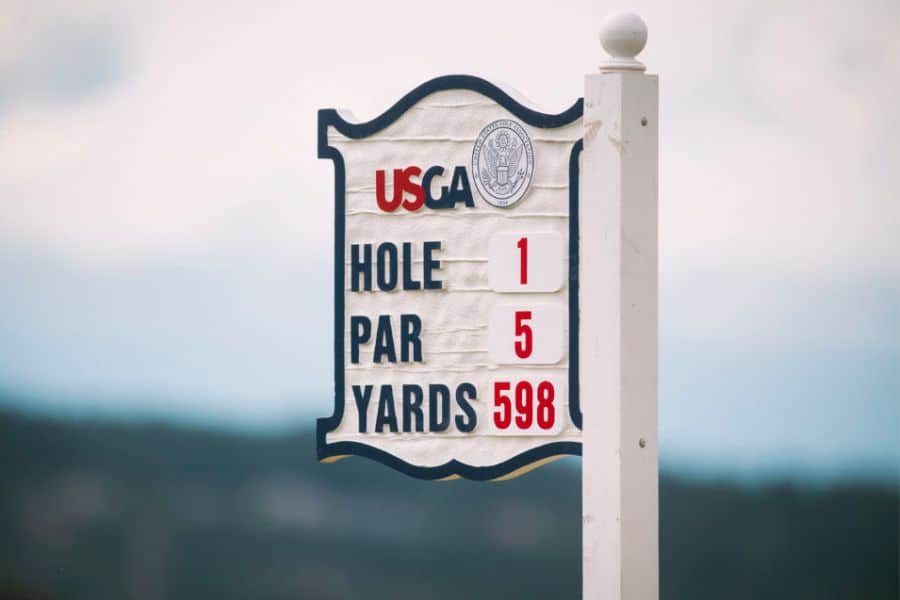What Is Par In Golf? Golf Scoring Term Explained

Golf requires passion, precision, and patience. Beginners might find the terminology and scoring complex.
It’s a term resonating with all golfers. From the fresh-faced amateurs teeing off for the first time to the seasoned pros facing down the pressure of the final holes.
In this detailed article, we’ll dive deep into the concept of “par” in golf. We’ll uncover its roots, understand its importance, and share practical strategies for golfers looking to master this crucial element of the game.
I. What Is Par In Golf?
In simplest terms, “par” is a term used in golf to refer to the number of strokes a skilled golfer should require to complete a hole. It is essentially the benchmark for scoring in golf and is determined by the length and difficulty of each individual hole.
II. The Origin of “Par”
The term “par” in golf is derived from the stock market, wherein a company’s stock may be above or below its standard value. In 1870, Mr. AH Doleman asked golf professionals David Strath and James Anderson what score would be needed to win the then-trophy for The Open, Prestwick’s annual tournament held since 1861.
Strath and Anderson mentioned that if somebody played perfectly, they would score a 49 on Prestwick’s twelve holes. Mr. Doleman named this ‘par’ for Prestwick, and subsequently, Young Tom Morris won with two strokes more than the average ‘par’ score of 36 holes.
The term “par” in golf was first mentioned in Britain, but the bogey actually preceded it. Today’s rating system doesn’t use the par standard, which wasn’t created until later on.
The Ladies Golf Association started developing a national handicapping system for women back in 1893 so that by the end of the century, it would be largely completed. Men’s association followed a few years after being founded in 1894.
III. Different Types Of “Par”
In golf, the term “par” is represented by specific numbers: 3, 4, and 5. These numbers indicate the average number of strokes a player is expected to use to finish a hole.

Par-3: A “Par 3” is a hole that the golfer should be able to get on the green in one stroke and then putt the ball into the hole with two shots, for a total of three strokes. Par 3’s are usually the shortest holes on the course, but they’re not always easy.
Par-4: A “Par 4” is a hole type where the average golfer is expected to reach the green in two strokes, then putt once on the green for four shots. Par 4s can have a wide variance of distances, ranging from drivable yardage to over 500 yards for professional golfers.
Par-5: On a “Par 5”, the average golfer would need to hit the ball three times before getting onto the green. If you are above average and can hit the ball farther, take advantage of this by only needing two shots instead of three, like most people.
IV. What is par in golf for 18 and 9 holes?
Here are the typical par values for 18-hole and 9-hole golf courses:
Par for 18 holes:
A standard 18-hole golf course usually has a par score of 72. This means that a skilled golfer is expected to complete the entire course in 72 strokes, with an average par value of 4 strokes per hole. However, the actual par value for each hole can vary depending on factors such as the distance, terrain, and hazards.
Par for 9 holes:
A 9-hole golf course will usually have a par score of 36, with an average par value of 4 strokes per hole. However, like with 18-hole courses, the actual par value for each hole can vary depending on the specific course design and layout.
V. How is par calculated?
The par for a hole is determined by a few different factors. The most important factor is the length of the hole. This can be measured in yards or meters. The second factor is the terrain. If the terrain is flat, then the par will be lower than if there are hills or other obstacles.
The third factor is the number of hazards of the hole. Water hazards, bunkers, and out-of-bounds areas can all increase the par for a hole.
The fourth and final factor is the difficulty of the green. If a green has a lot of undulations or is surrounded by bunkers, then it will typically have a higher par than a flat green with no bunkers.
VI. Is It Good to Make a Par?
Scoring par is a positive accomplishment for golfers of all levels, whether they play casually or competitively.
Simply consistently scoring par on a par-72 course might not be sufficient to become a professional golfer. If you observe PGA Tour events, you’ll notice that players typically need to shoot rounds in the mid-60s to secure a win, which is significantly lower than par.
There are exceptions, like major championships such as the U.S. Open, where the course is so tough that a par score is more like what would usually be considered a birdie. But for most amateur players, those kinds of situations are rare. Regular golf courses set up for amateur play usually offer a fairer challenge.
VII. Factors Influencing Par
Let’s have a look at the factors influencing par:
1. Course Difficulty
Courses are rated for difficulty. This directly affects the par assigned to them. Factors such as hole length, hazards, undulating terrain, and green speed all contribute to the rating. A par-3 on a championship course might be as challenging as a par-5 on a not-so-difficult course.
2. Weather Conditions
In golf, Nature plays a big role. Wind, rain, and heat can change how hard a hole is, making the par harder to predict. As conditions shift, so does the challenge of each hole which keeps players on their toes.
3. Player Skill Levels
Par is typically set based on what an average golfer is expected to achieve. However, every golfer is unique, and individual skill levels, strengths, and weaknesses greatly influence how they meet par. This highlights the personalized nature of the game, where each player approaches the challenge in their own way.
VIII. Can par on hole be different for men and women?
In most cases, yes. The USGA (United States Golf Association) has different sets of rules for men’s and women’s courses, which include different yardage requirements. As such, it’s not uncommon for there to be slight variations in the par for men’s and women’s courses.
The USGA’s Par Yardage Guidelines For Men And Women Are As Follows:
| Par | Men | Women |
| 3 | Up to 260 yards(240 meters) | Up to 220 yards(200 meters) |
| 4 | 240 to 490 yards(220 to 450 meters) | 200 to 420 yards(180 to 380 meters) |
| 5 | 450 to 710 yards(410 to 650 meters) | 370 to 600 yards(340 to 550 meters) |
| 6 | 670 yards and up(610 meters and up) | 570 yards and up(520 meters and up) |
IX. What is the easiest hole to par?
For new golfers, getting a par score is often easier on par 5 and par 3 holes. Par 3s need a precise first shot to reach the green, but they’re shorter, so shorter irons can be used. Two putts on the green can secure a par.
Par 5s allow more strategy options. While a strong tee shot and second shots are key, the approach to the green is usually shorter.
Par 4s are the toughest to par. You need a great tee shot and a longer second shot, typically between 130 to 210 yards. It’s hard to accurately hit the green from this distance.
Conclusion
In golf, “par” refers to the number of strokes a golfer should take to complete a given hole. The course designer typically sets this number. It ranges from 3 to 5 depending on factors such as length and difficulty. Golfers often see a par on a hole as a badge of honor. Knowing what exactly constitutes a par can help you set realistic goals for your game and measure your progress over time.
FAQ’s
1. What Is A Birdie?
A birdie is a term used in golf to describe a score of one stroke under par on a hole. This means that a golfer has completed a hole in one stroke less than the number of strokes expected of a skilled player. For example, a birdie on a par-4 hole means the player completed the hole in three strokes.
2. Are All Golf Courses Par 72?
No, not all golf courses are par 72. While 72 is the standard par score for a full 18-hole golf course, the actual par score for a particular course can vary depending on several factors.
Additionally, shorter courses or those designed for beginners may have fewer holes and a lower par score, such as a par-27 or par-30 for 9 holes.
3. Which Is The Rarest Type Of Score In Golf?
The rarest type of score in golf is a condor, which is a hole completed in four strokes under par. This is an extremely rare occurrence and usually requires hitting the ball directly into the hole from the tee (a hole-in-one) on a par-5 hole, or holing out a second shot from the fairway on a par-6 hole.
4. What Does “Par For The Course” Mean?
In golf, “par for the course” refers to the total number of strokes that a skilled golfer is expected to take to complete a particular course. A golfer who completes a hole in the expected number of strokes is said to have scored “par”. A golfer who completes a course in the expected number of strokes is said to have shot “par for the course”.








